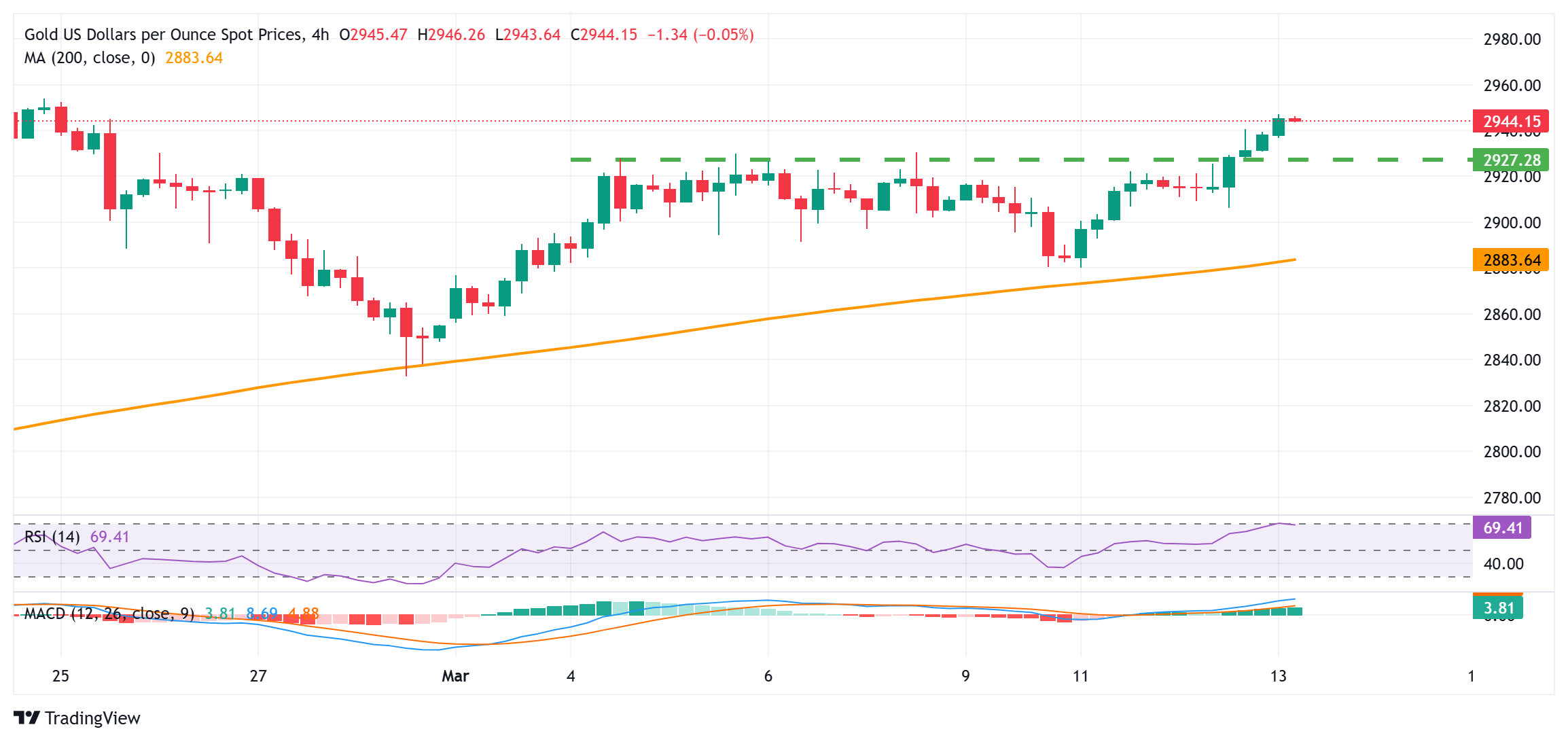Gold prices attracted buyers for the third consecutive day, rising to a two-week high.
Trade war concerns, Fed rate cut bets and a bearish US dollar supported the precious metal's upside momentum.
Traders are now looking forward to the release of the US PPI report for additional momentum.
Gold prices (XAU/USD) traded on a positive note during the Asian session on Thursday, rising for the third consecutive day, climbing to around $2,942-2,943 area, hitting a two-week high. Concerns about rising trade tensions and a possible economic slowdown due to US President Donald Trump's tariffs continue to provide support for the safe-haven metal. Apart from this, the market's growing acceptance that the Federal Reserve (Fed) will cut interest rates multiple times this year has also become another factor in favor of the low-yielding yellow metal.
US consumer inflation data released on Wednesday came in below expectations, accompanied by signs of a cooling labor market. Moreover, uncertainty over Trump’s policies could force the Fed to resume its rate-cutting cycle in June, further depressing the U.S. dollar (USD) to near its lowest level since Oct. 16 and providing additional support for gold prices. Nevertheless, overall positive risk sentiment could pose some headwinds for the gold/USD pair.
Uncertainties surrounding U.S. President Donald Trump’s aggressive trade tariffs have heightened concerns about a potential economic slowdown, continuing to push investors toward traditional safe-haven assets.
Trump’s 25% tariff on all steel and aluminum imports took effect on Wednesday. In addition, Trump threatened to respond to any countermeasures announced by the European Union and Canada.
The European Commission said on Wednesday that the European Union will impose tariffs on $28 billion worth of U.S. goods starting next month, while Canada announced a 25% tariff on more than $20 billion worth of U.S. goods.
In addition, a cooling U.S. inflation report released on Wednesday raised market bets that the Federal Reserve will cut interest rates three times by 25 basis points each at its monetary policy meetings in June, July and October.
The report released by the U.S. Bureau of Labor Statistics (BLS) showed that the consumer price index (CPI) fell to an annual rate of 2.8% in February, lower than the 3% expected last month.
In addition, the core index, which excludes volatile food and energy prices, rose 3.1% year-on-year in the reporting month, slowing from a 3.3% increase in January.
The U.S. dollar index, which measures the performance of the U.S. dollar against a basket of currencies, hovered at its lowest level since October 16, pushing gold prices up for a third consecutive day on Thursday.
Traders are now looking ahead to the US economic calendar, watching for the release of the Producer Price Index (PPI) for fresh momentum and to take advantage of short-term opportunities during the North American session.

From a technical perspective, the sustained breakout above the $2,928-2,930 horizontal resistance overnight supports prospects of challenging the all-time high of $2,956 area reached on February 24. Considering that the oscillators on the daily chart remain comfortably in the positive territory and are still far from entering the overbought zone, subsequent buying will be seen as a new trigger for the bulls. This will set the stage for the continuation of the ongoing uptrend seen over the past three months or so.
On the other hand, the $2,930-2,828 resistance level seems to protect the short-term downside risk. If it falls below this level, the gold price may accelerate its decline to the intermediate support level of $2,912-2,910, and then approach the $2,900 round mark. Next is the weekly low, which is around the $2,800 area. If the $2,860 area is decisively broken, it may pave the way for a deeper decline. The gold/dollar currency pair may then slide to the lows of late February, around the $2,833-2,832 area, and finally fall to the $2,800 mark.
Gold has played a key role in human history as it is widely used as a store of value and a medium of exchange. Currently, in addition to its lustre and use in jewellery, gold is widely viewed as a safe haven asset, meaning it is considered a good investment in turbulent times. Gold is also widely seen as a hedge against inflation and currency debasement because it is not dependent on any particular issuer or government.
Central banks are the largest holders of gold. To support their currencies during turbulent times, central banks tend to diversify their reserves and buy gold to boost perceptions of economic and monetary strength. High gold reserves can be a source of trust in a country's solvency. According to the World Gold Council, central banks added 1,136 tonnes of gold to their reserves in 2022, worth about $70 billion. This is the highest annual purchase on record. Central banks in emerging economies such as China, India and Turkey are rapidly increasing their gold reserves.
Gold is negatively correlated with the US dollar and US Treasuries, both of which are major reserve assets and safe haven assets. Gold tends to rise when the dollar weakens, allowing investors and central banks to diversify their assets during turbulent times. Gold is also negatively correlated with risky assets. A rally in the stock market tends to push gold prices lower, while a sell-off in riskier markets tends to favor gold.
Prices can move due to a wide variety of factors. Geopolitical instability or fears of a deep recession can quickly push gold prices higher due to its safe-haven status. As a low-yielding asset, gold tends to rise as interest rates fall, while higher funding costs usually weigh on gold. Still, since the asset is priced in U.S. dollars (XAU/USD), most moves depend on the performance of the U.S. dollar (USD). A strong dollar tends to control gold prices, while a weak dollar can push them higher.